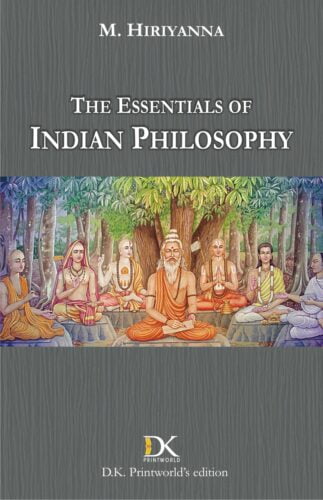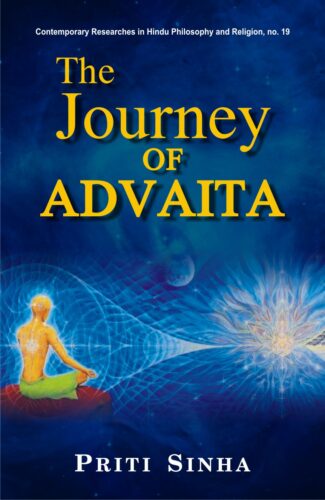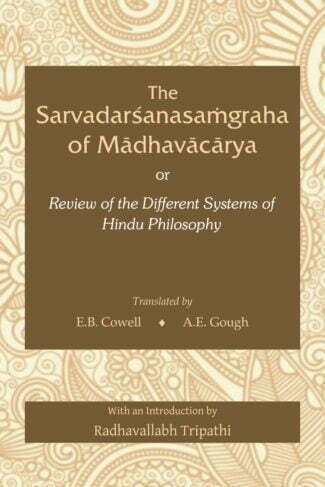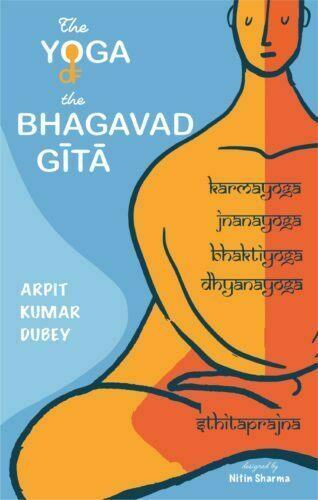Showing 221–230 of 270 results

This volume deliberates on the “essentials” of Indian philosophy allowing one to peruse, analyse and absorb its crux. It has set its focus on the history of Indian philosophy starting from the course of Vedic religion, its transition to the prominent systems, its intake from the non-Vedic schools of thought, and the details and analysis of NyÀya-VaieÈika, SÀÚkhya-Yoga, PÂrva-MÁmÀÚsÀ, and VedÀnta from both an absolutistic and a theistic approach.
As the title indicates, this volume deliberates on the essentials of Indian philosophy allowing one to peruse, analyse and absorb its crux. It has set its focus on the history of Indian philosophy starting from the course of Vedic religion, its transition to the prominent systems, its intake from the non-Vedic schools of thought, and the details and analysis of NyÀya-VaieÈika, SÀÚkhya-Yoga, PÂrva-MÁmÀÚsÀ, and VedÀnta from both an absolutistic and a theistic approach. The book portrays the authentic chronological limits of these systems, disagreeing many a theory and study. Its in-depth but concise and connecting account of Indian philosophical systems has vivid interpretations and daunting criticisms. A historical survey accompanies each natural division of the subject along with its theory of knowledge, ontology and practical teaching. It makes one grasp the fundamentals of Indian philosophy at ease and navigate further to its nuances across a vide spectrum of readers.

The Gospel of Buddha sketches the picture of a religious leader of the remote past with a view of make it bear upon the living present and become a factor in the formation of the future. It essentially talks about all major developments in the life of the Buddha and helps all true Buddhists understand the real tenets of Buddhism to stand firm on ground.
The Gospel of Buddha characterizes the spirit of Buddhism correctly and concisely. It draws parallelisms in Western thoughts, especially those which reflect in the Christian Gospels. Buddhism like Christianity has a number of sects and this book, however, does not side with any sectarian tenets, but takes an ideal position upon which all true Buddhists may stand up as on firm ground. It helps people to comprehend Buddhism better in an easy way and it sets the reader thinking on the problems and challenges of religions today.
It sketches the picture of a religious leader of the remote past with a view of make it bear upon the living present and become a factor in the formation of the future. It essentially talks about all major developments in the life of the Buddha – his transformation from Prince SiddhÀrtha to the Buddha, to his founding of the Kingdom of Righteousness, to the consolidation of his religion, to his teachings, and to the parables and stories that he used, to his last days.
This book is expected to serve both the Buddhists and Christians to penetrate deep into the spirit of their faith so as to see its full length, breadth and length.

The Journey of Advaita elucidates the richness, depth and profundity of Advaitic thought right from the Vedas to the Integral Advaitism of Sri Aurobindo, and further how it is being incorporated in modern science. In its long journey, it found its blossom in Shankaras Kevaladvaita, and in its further growth, Bhakti-Vedanta played an important role through Ramanuja, Madhva, Nimbarka and Vallabha.
The Journey of Advaita elucidates the richness, depth and profundity of Advaitic thought right from Vedas to Integral Advaitism of Sri Aurobindo and further how it is being incorporated in modern science.
Advaita Philosophy is not a later development of thought as one of the six systems of Indian philosophy. Vedas are replete with suggestions about Unity. The earlier stage of naturalistic and anthropomorphic polytheism yielded to monistic belief. In the dictum, ekam sad vipra bahudha vadanti we perceive an echo of Unity. Upanishadic seers picked up this Unity and tirelessly went in their search till they came to the highest conclusion, tat tvam asi.
This concept of Unity gets its full bloom in Shankaras Kevaladvaita; later on it gave inspiration to different rivulets of Vedanta schools. Shankaras unqualified impersonal Brahman could not satisfy those who sought loving communion with God. Consequently different schools of Bhakti-Vedanta came into existence, namely, Vishishtadvaita of Ramanuja, Dvaita of Madhva, Dvaitadvaita of Nimbarka and Shuddhadvaita of Vallabha. For all of them the emphasis is on the liberation of individual soul only, which gave way to Sri Aurobindos Integral Advaitism where the emphasis is not only on spiritualization of man but of the whole cosmos.
The journey continues further with modern physics. Consciousness is the building block of the Universe and the ground of all beings, which cant be found in plural.

This book in three parts is unique as it depicts the life of this spiritual preceptor, chronologically detailing the varied roles he played to change the social, economic, political, religious and spiritual life of the people and the countless incredible miracles he performed during his 72 years of worldly existence.
The relevance and importance of the teachings of the saint-poet-philosopher-social reformer Sree Narayana Guru are increasing day by day and have been influencing millions of people all over the world. Of the hundreds of biographies of Guru, this book in three parts is unique as it depicts the life of this spiritual preceptor, chronologically detailing the varied roles he played to change the social, economic, political, religious and spiritual life of the people and the countless incredible miracles he performed during his 72 years of worldly existence.
The book provides an in-depth study of the social conditions prevailing in the nineteenth and twentieth centuries of Kerala. A picture is clearly drawn on how an avarna liberated a society steeped in ignorance to such heights that the higher-ups in social order could not even dream of, by a bloodless spiritual revolution. The different roles Guru enacted in his life and the numerous miracles he performed, not highlighted so far in any biography, find a prominent place in this book. The life of Guru is presented here as it was. Readers can form their own conclusions about this great soul. The Foreword by Prof. M.K. Sanoo is a window to enter into the insight of the life of the Guru.

It shows how reality is generated in a recursive fashion and uses this insight to illuminate many puzzles of history and culture. The book straddles history and science, aesthetics and religion, and politics and power, by juxtaposing material in ways that provide surprising new insights.
The Loom of Time shows how reality is generated in a recursive fashion and uses this insight to illuminate many puzzles of history and culture. Recursion is at basis of mimicry in nature and germination and development of biological organisms; it also provides structure to mental images of physical systems and human behavior. It helps us make sense of the repeating patterns across cultures and nations, understand the manner in which technology is impacting society, and see the reasons behind the crises of the contemporary world.
The topics covered in this book include philosophical bases of recursion, cosmologies old and new, religion and modernity, globalization and bureaucratic control, loss of meaning and freedom, spirituality, narcissism leading to despair, and limits of medicine. It deals with problems of employment and questions of meaning of life when robots and other machines become more numerous than humans. The book straddles history and science, aesthetics and religion, and politics and power, by juxtaposing material in ways that provide surprising new insights.

This book discusses the quintessential aspects of George Santayana’s wide and comprehensive philosophy. Its critical and comparative discussions have taken place centring round the problems of Epistemology, Metaphysics, Aesthetics, Ethics and Religion, thereby making it all the more interesting.
This book discusses the quintessential aspects of George Santayana’s wide and comprehensive philosophy. Its critical and comparative discussions centre round the problems of Epistemology, Metaphysics, Aesthetics, Ethics and Religion. This makes it all the more interesting.
What is noteworthy about this book is that it shows how naturalism serves as a basis of the idealistic philosophy of George Santayana. Moreover, the illustrious part of this treatise is that essence, as discovered by Santayana by the doubting process, serves as the keynote of his whole philosophy.
The exposition of Santayana’s philosophy on the basis of the above two points is an outstanding feature of the present work. What is captivating about this book is that it shows how the natural gets reconciled with the ideal by making the former the ground of the latter.

This book is an interesting specimen of Hindu critical ability. It presents the synopsis of sixteen philosophical systems that were current in the fourteenth-century south India in their most important tenets and maintains the principal arguments by which their followers were endeavoured to maintain them.
The Sarvadarshanasamgraha of Madhavacharya is an interesting specimen of Hindu critical ability. The author herein presents the synopsis of sixteen Charvaka, Bauddha, Jaina, Ramanuja, Purnaprajna, Pashupata, Shaiva, Pratyabhijna, Raseshvara, Vaisheshika, Nyaya, Jaiminiya, Paniniya, Samkhya, Patanjala and Advaita philosophical systems current in the fourteenth-century south India in their most important tenets and maintains the principal arguments by which their followers were endeavoured to maintain them. In course of his sketches of these systems, Madhavacharya frequently explains at length obscure details of these different systems.
Sarvadarshanasamgraha presents all these Darshanas from the Vedantic point of view. These had attracted to their study the noblest minds in India throughout the medieval period of its history. There were numerous sects of Bauddha, Jaina, and Hindu philosophical systems and we come across many of them in this book.
This present retypeset edition is quite reader-friendly as we have made a few changes to this edition as value-adds and by incorporating the present-day diacritics.
This English translation of Sarvadarshanasamgraha must evoke keen interest among scholars of philosophy, and researchers and students of philosophy across the globe.

This volume critically examines six epistemological theories of the Advaita school of Vedanta: pratyaksha (perception), upamana (comparison), anupalabdhi (non-cognition), anumana (inference), arthapatti (postulation) and shabda (testimony), highlighting the problems, concepts and theories of the Vedantins within the focus of modern Western thought.
This volume critically examines six epistemological theories of the Advaita school of Vedanta: pratyaksha (perception), upamana (comparison), anupalabdhi (non-cognition), anumana (inference), arthapatti (postulation) and shabda (testimony). To make the study smooth and easy, it deliberates on two other concepts prama (conceptions of knowledge) and pramana (methods of knowing) as these underlie all epistemological discussions.
The book highlights the problems, concepts and theories of the Vedantins within the focus of modern Western thought. The method adopted is one of critical analysis, comparison and evaluation. It also tries to formulate some important epistemological doctrines of Advaita Vedanta and show by some criticism that, if rightly understood, they are valuable contributions to the philosophy of the world.
The book, targeting sceptical students trained in Western philosophy and an imagined tribunal of Western philosophers, tries to make a case for Advaita Vedanta, and thus is expected to usher keen interest among the students, teachers and followers of Advaita Vedanta.

This volume presents the translation and interpretation of thirteen principal Upanisads such as Brhadaranyaka, Chandogya, Taittiriya, Aitareya, Kausitaki, Kena, Katha, Isa, Mundaka, Prasna, Mandukya, Svetasvatara and Maitri along with the outline of the philosophical wisdom inherent in these Upanisads. It also features the recurrent and parallel passages in these principal Upanisads and the Bhagavadgita.
Upanisads are an authoritative compendium of Indian metaphysics. They represent the earnest efforts of profound thinkers of early India to solve the problems of origin, nature, and destiny of man and the universe, more technically the meaning and value of knowing and being. They are replete with sublime conceptions and with intuitions of universal truth. These Upanisads sets forth two opposing theories: one of mundane life and the other relating to a life that is in search of the Supreme Reality and man’s ultimate aim.
Though, traditionally, 108 Upanisads are well known and subject to various studies, there are around 200 Upanisads in toto. Of them, this volume contains the translation and interpretation of thirteen principal Upanisads such as Brhadaranyaka, Chandogya, Taittiriya, Aitareya, Kausitaki, Kena, Katha, Isa, Mundaka, Prasna, Mandukya, Svetasvatara and Maitri along with the outline of the philosophical wisdom inherent in these Upanisads. It also features the recurrent and parallel passages in these principal Upanisads and the Bhagavadgita.

It vividly and graphically presents the key concepts of the Bhagavadgita while majorly discussing the concepts like atman, Paramatman, jagat, karma-yoga, jnana-yoga, bhakti-yoga, dhyana-yoga, sthitaprajna, sadhakas’ challenges and the ways out.
This volume covers all the aspects of Yoga and self-management discussed in the Bhagavadgita –– a comprehensive text of personal and professional life management and adhyatma-sadhana (spiritual upgradation). What makes the book special is its dialogue format between a guru and his disciple as exactly what we witness in the Bhagavadgita as between Sri Krsna and Arjuna.
It vividly and graphically presents the key concepts of the Bhagavadgita while majorly discussing the concepts like karma-yoga, jnana-yoga, bhakti-yoga, dhyana-yoga, sthitaprajna, and seven keys of self upgradation, which leads towards Health, Happiness and Harmony, challenges and the ways out.
This book will help in the making broader understanding of the concepts and philosophy of the Bhagavadgita, which transcends time and space, to register with the new generation readers and thereby emulate and practise the varied forms of Yoga.
| There are no products |